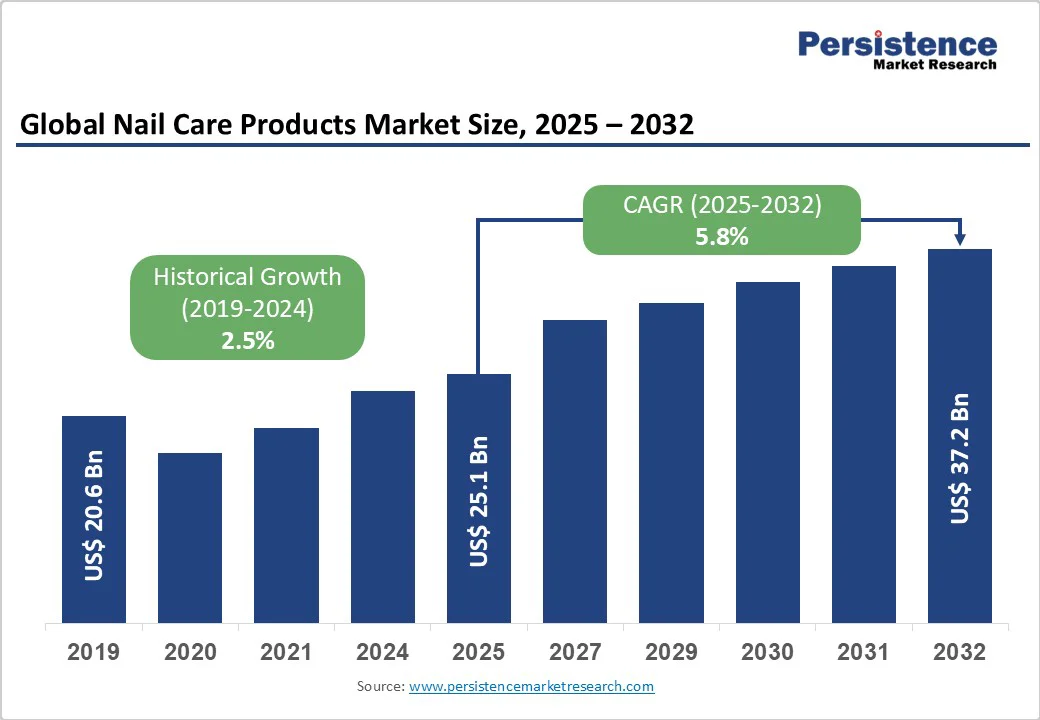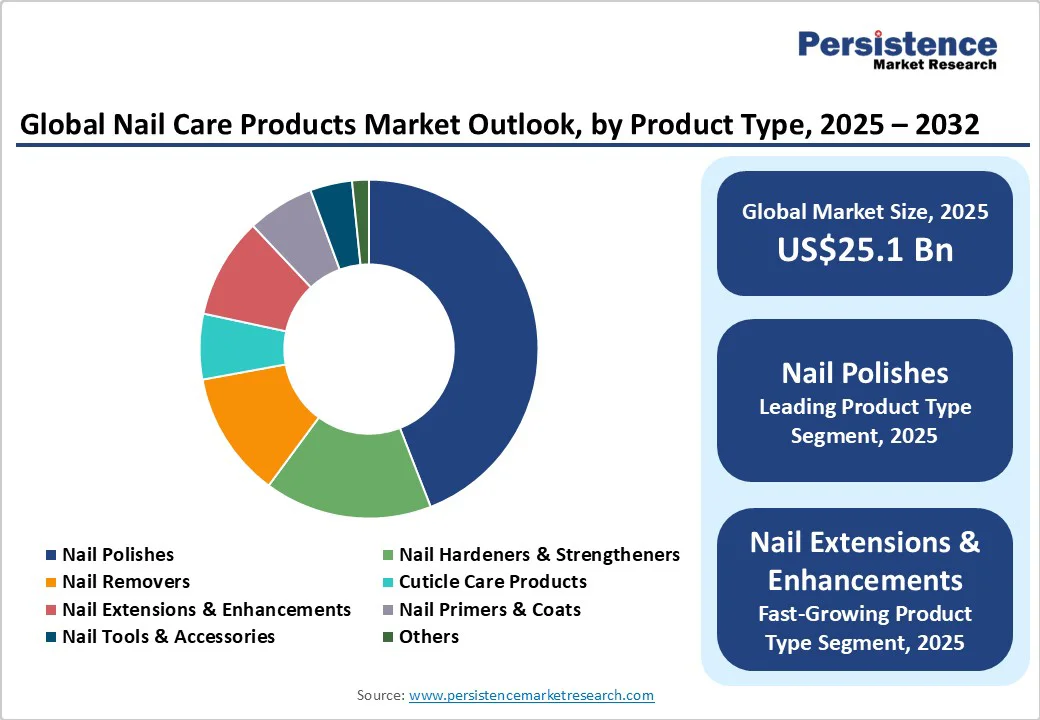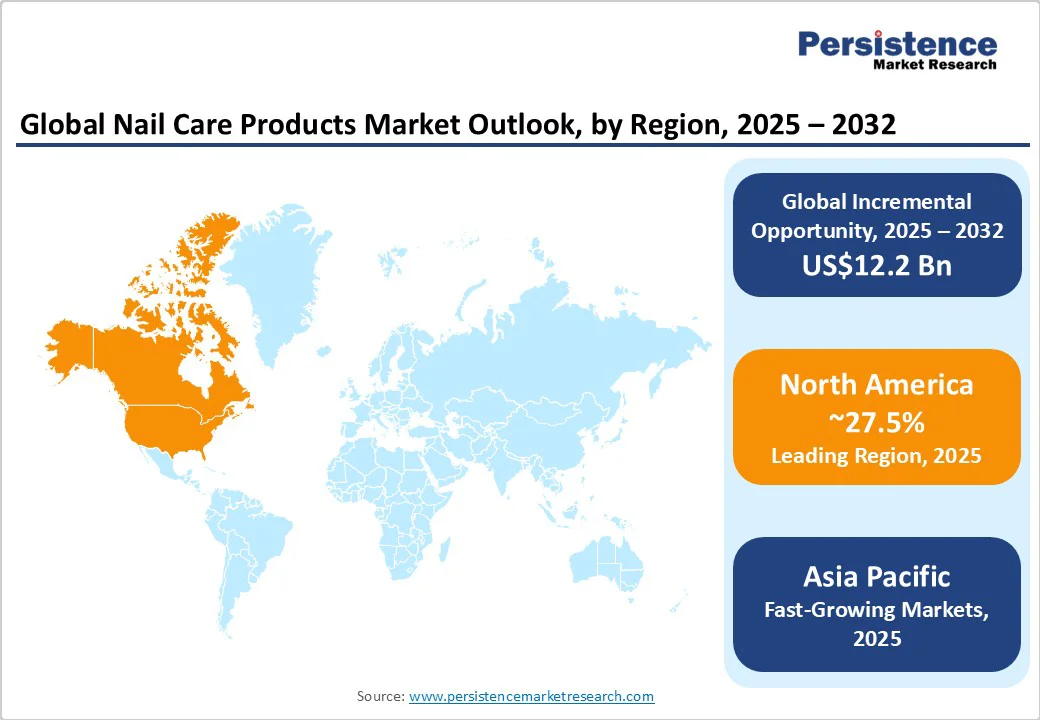ID: PMRREP33599| 183 Pages | 8 Oct 2025 | Format: PDF, Excel, PPT* | Consumer Goods

The global nail care products market size is likely to be valued at US$25.1 billion in 2025 and is expected to reach US$37.2 billion by 2032, growing at a CAGR of 5.8% during the forecast period from 2025 to 2032.
The surge in DIY nail art trends, coupled with the rapid expansion of e-commerce and beauty retail platforms, is making these products widely accessible. The shift toward vegan, organic, and chemical-free nail care solutions is appealing to health-conscious and eco-friendly buyers.
| Key Insights | Details |
|---|---|
| Nail Care Products Market Size (2025E) | US$25.1 Bn |
| Market Value Forecast (2032F) | US$37.2 Bn |
| Projected Growth (CAGR 2025 to 2032) | 5.8% |
| Historical Market Growth (CAGR 2019 to 2024) | 2.5% |

Technological innovation is driving growth in the nail care industry by enabling personalized, creative experiences. For instance, on May 16, 2024, Essie launched its Nail Art Studio, a DIY design platform that incorporates two groundbreaking technologies: Jelly Gloss and Special Effects.
These innovations enable consumers to create customized manicures with unique finishes and color washes, allowing both professionals and beginners to express their individuality. By leveraging digital and app-based tools, the platform will enable users to experiment with designs, enhancing engagement and accessibility. Such technology-driven innovations not only expand the consumer base but also strengthen brand loyalty, reflecting the broader shift toward interactive, experience-focused beauty solutions.
Growing consumer demand for ethical k-beauty products is pushing nail care product brands to adopt eco-friendly formulations and packaging. Essie’s Love Collection, launched on July 25, 2023, exemplifies this shift, featuring 17 vegan, 80% plant-based shades made from cotton, corn, and sugarcane, along with recyclable packaging that includes a 25% recycled glass bottle and a 93% PCR plastic cap.
Younger consumers increasingly favor cruelty-free, non-toxic products that reflect their environmental values. By combining sustainability with quality performance, Essie strengthens brand loyalty and differentiates itself in a competitive landscape, driving further innovation in eco-friendly nail care solutions.
The rise in consumer awareness about the use of chemicals such as formaldehyde, toluene, and dibutyl phthalate (DBP), which are linked to skin irritation, respiratory issues, and long-term health risks, has led to a shift in consumer perception toward nail care products. Worldwide, the regulatory bodies have imposed strict bans and safety standards, creating compliance challenges and forcing brands to invest heavily in R&D for safer, high-performing formulations.
For example, the EU banned TPO (trimethylbenzoyl diphenylphosphine oxide) in gel nail polishes/products starting September 1, 2025, under its delegated regulation Omnibus VII, which classifies TPO as carcinogenic, mutagenic, or toxic to reproduction. While clean, vegan, cruelty-free, and eco-friendly alternatives are gaining traction, reformulating products without compromising performance increases production costs and limits margins.
As a result, brands that fail to adapt risk losing consumer trust and facing slower product launches.
The nail care products market is highly competitive and saturated, with established global brands such as OPI, Essie, and Sally Hansen dominating the space. Meanwhile, luxury and indie brands continually introduce new collections, which limit growth opportunities for new entrants. High marketing, influencer partnerships, and retail expansion costs, coupled with fast-changing consumer preferences, shorten product life cycles and strain profitability.
Discount-driven pricing strategies and private-label alternatives from retailers like Ulta and Sephora intensify price competition, making it challenging for brands to maintain their margins. Without strong differentiation and brand loyalty, small and emerging brands risk being overshadowed by industry leaders, which can constrain overall market expansion.
The growing popularity of space-themed nail polish collections is transforming the market, driven by consumer interest in STEM-inspired beauty products. Orly’s NASA X Orly collection, launched on March 1, 2023, featuring shades like Perseverance Red Rover Shimmer and Golden Record Gold Metallic, showcases the fusion of science, space, and cosmetic innovation.
Limited-edition collaborative lines are creating unique, storytelling-driven nail experiences that appeal to enthusiasts of both beauty and science. This development presents opportunities for brands to create astronomy-inspired, futuristic nail polish collections, catering to consumers who seek visually striking and educational products.
With growing fascination for science-meets-beauty products, the nail care market is poised for increased demand for creative, immersive nail offerings.
Digital technologies are transforming consumer experiences, as seen with Sally Hansen’s AR-powered virtual try-on tool, launched on February 8, 2022, utilizing Perfect Corp.’s AgileHand Technology. This allows users to experiment with hundreds of nail colors in real-time.
Movie-themed collaborations, such as the Sally Hansen x Trolls Band Together collection, which launched on September 1, 2023, leverage pop culture to attract new audiences and foster brand loyalty. By combining AR, AI-driven personalization, influencer partnerships, and interactive digital campaigns, brands enhance product discovery, purchase confidence, and market presence.
Investing in advanced e-commerce capabilities and immersive digital experiences positions companies to meet the growing demand from tech-savvy consumers.
Nail polishes are expected to account for more than 55.3% share in 2025 due to affordability and constant demand for new shades. They directly fulfill consumers’ desire for self-expression, fashion, and personal grooming. Busy lifestyles and the popularity of at-home manicures make them a convenient choice. Rising demand for vibrant, long-lasting, and quick-dry formulations caters to aesthetic and time-saving needs.
Nail extensions and enhancements are expected to grow at a CAGR of 7.2%, reaching US$4.2 billion by 2032, driven by consumers' increasing interest in creative self-expression. Social media trends inspire intricate nail art designs, promoting personal branding and confidence. Younger demographics, particularly millennials and Gen Z, seek innovative, eco-friendly products that align with health-conscious wellness routines, strengthen natural nails, and minimize damage.
The mass segment is expected to account for over 61% share in 2025, serving a broad consumer base focused on affordability and accessibility. Consumers prioritize cost-effective solutions for everyday nail maintenance, such as basic nail polishes, nail strengtheners, and cuticle care.
The convenience of widely available products in supermarkets, drugstores, and online platforms meets the daily grooming needs of budget-conscious users. Frequent usage and the need for regular replacement drive demand for products in the mass market price range.
The premium pricing level is expected to grow at the highest rate due to rising consumer demand for high-quality, long-lasting, and safe formulations. Consumers increasingly seek products with advanced ingredients, such as nail-strengthening, vegan, or eco-friendly options, that enhance nail health. Professional salon-quality finishes and luxury brand appeal also drive willingness to pay more.
The offline segment is expected to account for more than 65% share in 2025 due to consumers preferring to see, feel, and test products before purchase, ensuring the right shade, texture, and quality. Salons, beauty stores, and pharmacies also provide personalized advice and professional recommendations, which enhance trust and purchase confidence. Offline stores offer immediate availability, catering to urgent needs or last-minute purchases, making them the preferred choice for many consumers.
Online sales are expected to grow at the highest rate, with a CAGR of 7.4% as consumers increasingly seek convenience, 24/7 accessibility, and a wider variety of brands and products than physical stores offer. The ability to read reviews, compare prices, and explore new trends online meets the demand for informed and personalized purchasing. The rise of social media tutorials and influencer recommendations drives online discovery and impulse buying.
Individual Consumers are expected to account for over 59.6% of the market share in 2025, driven by rising personal grooming and self-care awareness. Busy lifestyles and the popularity of at-home manicures drive frequent purchases of nail polishes, treatments, and tools.
Consumers increasingly seek products that cater to convenience, aesthetic appeal, and customization, including trendy colors and nail care solutions. The growing interest in hygiene, hand care, and achieving professional-quality results at home further fuels demand.
Professional salons and spas are expected to grow at a significant rate due to customer needs for personalized, high-quality grooming experiences, such as custom nail art with gems and 3D designs that at-home products can't replicate. Rising awareness of nail health and the use of premium, long-lasting products is driving an increase in frequent visits.

North America is expected to account for a share of more than 27.5% in 2025, driven by advanced infrastructure, high consumer awareness, and a strong professional salon ecosystem. Social media platforms like Instagram and TikTok boost nail art trends, encouraging experimentation with colors and designs, while aging populations and health-conscious consumers seek strengthening and nourishing treatments.
Regulatory changes, including FDA actions on prohibited ingredients (2024 - 2025) and Canada’s Cosmetics Regulation updates (October 2024), promote cleaner formulations and clear labeling, increasing demand for compliant products. The U.S. nail care products market, estimated to reach US$6.9 billion by 2032 with a CAGR of 3.5%, benefits from high disposable income, innovation adoption, and a strong salon culture.
The Asia Pacific is the fastest-growing region, with a CAGR of 7.9%, driven by urbanization, rising disposable incomes, and increased female workforce participation in China, India, and South Korea, which boosts demand for regular nail care and protective products.
Youth in India and Southeast Asia drive trends in colorful, expressive designs, while China leads consumption with digitally native consumers and a growing salon culture. Japan and South Korea focus on innovative gel-based, long-lasting products, supported by K-beauty trends and events like the Korea Beauty Expo, whereas India and ASEAN adopt mass-market offerings.
Low-cost manufacturing, government-backed cosmetics clusters, evolving regulations (India’s BIS, China’s NMPA), and cross-border e-commerce further support growth, with China’s retail sales of consumer goods surpassing 48 trillion CNY in 2024, up 3.5% YoY.
Europe is expected to account for a share of over 25% in 2025, driven by millennials and Gen Z favoring premium, professional-quality, eco-conscious, and vegan products. Busy lifestyles and at-home manicures are driving the growth of gel polish and nail kit sales.
France’s luxury beauty culture and urban fashion trends, along with Poland’s rising disposable income, are key demand drivers, while EU safety regulations support the adoption of eco-friendly products. Salon penetration and fashion-forward consumers fuel growth in Spain and Italy, where a study found a 2.1% positive reaction to 2-HEMA in 2025, up from 1.6% in 2019, increasing demand for hypoallergenic products.

The nail care products market is highly fragmented, with numerous global and regional players competing across premium and mass-market segments. Manufacturers are focusing on frequent product launches, collaborations with fashion and entertainment brands, and limited-edition collections to capture consumer attention.
Many brands are focusing on clean-label nail care, vegan formulations, and sustainable nail products that resonate with eco-conscious buyers. Digital-first strategies such as influencer marketing, social media campaigns, and omnichannel distribution are being adopted to boost brand visibility, expand reach, and build customer loyalty.
The global nail care products market is projected to be valued at US$25.1 Bn in 2025.
Rising consumer focus on personal grooming, increasing fashion-consciousness are key drivers of the market.
The nail care products market is poised to witness a CAGR of 5.8% from 2025 to 2032.
Digital innovations such as virtual try-on tools and rising demand for eco-friendly and non-toxic formulations are creating strong growth opportunities.
L'Oréal Groupe, Coty Inc., Wella Company, The Estée Lauder Companies Inc., Shiseido Co. Ltd., Revlon Inc., Dior, Chanel Inc. are among the leading key players.
| Report Attribute | Details |
|---|---|
| Historical Data/Actuals | 2019 - 2024 |
| Forecast Period | 2025 - 2032 |
| Market Analysis | Value: US$ Bn/Mn, Volume: As Applicable |
| Geographical Coverage |
|
| Segmental Coverage |
|
| Competitive Analysis |
|
| Report Highlights |
|
By Product Type
By Pricing Level
By Distribution Channel
By End User
By Region
Delivery Timelines
For more information on this report and its delivery timelines please get in touch with our sales team.
About Author